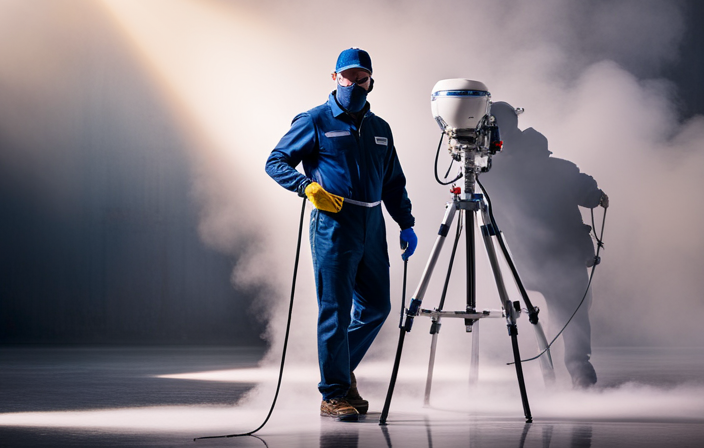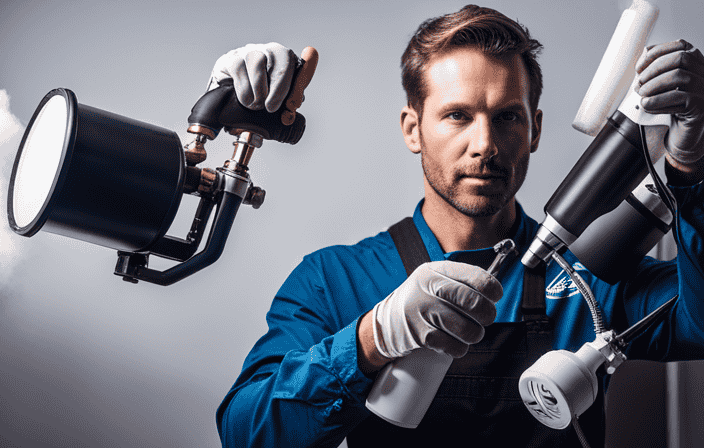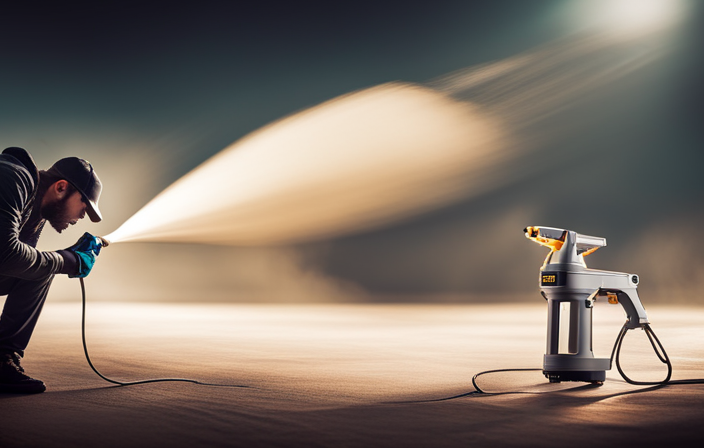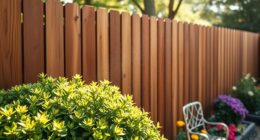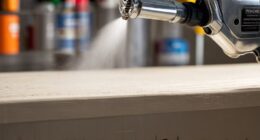Did you know that using an airless paint sprayer could potentially cut your painting time by up to 40% when compared to traditional methods like using a brush or roller? If you want to achieve a professional quality finish in your painting projects, mastering the operation of an airless paint sprayer is crucial.
In this article, I will guide you through the process of using an airless paint sprayer like a pro. From understanding the basics and preparing your work area to choosing the right paint and equipment, I will provide you with detailed steps and tips to help you achieve a flawless result.
I will also cover troubleshooting techniques for dealing with clogs, as well as cleaning and maintenance guidelines to keep your sprayer in top shape. By following the proper spraying techniques and implementing the safety precautions, you’ll be able to transform your painting projects into professional masterpieces.
So let’s dive in and learn how to use an airless paint sprayer like a pro!
Key Takeaways
- Hold the sprayer firmly and maintain a consistent distance of about 12 inches from the surface.
- Start each stroke slightly before the previous one ends to ensure even distribution.
- Use drop cloths and masking tape to protect surfaces and minimize mess.
- Clean up any drips or overspray immediately to prevent them from drying and becoming difficult to remove.
Understanding the Basics of an Airless Paint Sprayer
If you want to paint like a pro, it’s important to understand the basics of an airless paint sprayer. These powerful tools can make your painting projects faster and more efficient, but they also require some knowledge to use them safely.
Understanding safety measures is crucial when using an airless paint sprayer. Always wear protective gear like goggles, gloves, and a respirator to prevent any accidents or health issues.
Additionally, make sure to troubleshoot common issues that may occur, such as clogged nozzles or uneven spray patterns. By familiarizing yourself with these safety measures and troubleshooting techniques, you can ensure a smooth painting process.
Now, let’s move on to preparing your work area and getting ready for the painting job ahead.
Preparing Your Work Area
Before starting to paint, I always make sure to clear and cover any furniture and flooring in the work area to avoid any accidental paint splatters or damage. This involves removing any objects that can be moved, covering larger furniture pieces with plastic or drop cloths, and using painter’s tape to protect baseboards and trim.
Additionally, I take the time to properly prep the surfaces to be painted by cleaning them, filling in any holes or cracks, and sanding them smooth. This ensures a clean canvas for the paint to adhere to and helps to achieve a professional-looking finish.
Clearing and Covering Furniture and Flooring
First, carefully move your furniture out of the room to make way for your painting project, ensuring that your floors are completely clear and ready for the transformation.
To protect your furniture and flooring during the painting process, here are three essential covering techniques:
- Use plastic drop cloths: Cover your furniture with plastic drop cloths to shield them from any paint splatters or drips.
- Lay down canvas drop cloths: Place canvas drop cloths on the floor to protect your flooring from paint spills and stains.
- Secure with painter’s tape: Use painter’s tape to secure the drop cloths in place, ensuring they stay put and provide full coverage.
By following these covering techniques and protecting surfaces, you can prevent any accidental damage and keep your furniture and flooring in pristine condition.
Once you have cleared and covered your furniture and flooring, it’s time to move on to prepping the surfaces to be painted.
Prepping the Surfaces to be Painted
Now that you’ve successfully protected your furniture and flooring, it’s time to get those surfaces prepped for a flawless paint job.
Before starting, make sure to remove any loose paint or imperfections by using sanding techniques. This will ensure a smooth and even surface for the paint to adhere to. Start by sanding in a circular motion, gradually moving the sander back and forth. Be sure to pay extra attention to any rough areas or edges.
Once the surfaces are smooth, it’s important to prime them before applying paint. Priming helps to seal the surface, providing a better adhesion for the paint and preventing any stains or discoloration from bleeding through.
Now that the surfaces are properly prepped, let’s move on to choosing the right paint and equipment for the next step.
Choosing the Right Paint and Equipment
When it comes to selecting the appropriate paint for your project, there are a few key points to keep in mind.
First, consider the surface you will be painting and choose a paint that is suitable for that specific material.
Next, think about the finish you desire and select a paint that will achieve that look.
Additionally, it is crucial to use the correct tips and nozzles for your airless paint sprayer. The size and type of tip you use will determine the spray pattern and coverage of the paint, so be sure to choose the right ones for your project.
Selecting the Appropriate Paint for Your Project
To achieve professional results with your airless paint sprayer, it is important to select the appropriate paint for your project. Here are some tips to help you choose the right paint:
-
Consider the paint finish: Different finishes, such as matte, satin, or gloss, can create different effects. Choose a finish that suits the desired look and feel of your project.
-
Know the surface you’re painting: Different surfaces require different types of paint. For example, if you’re painting a metal surface, choose a paint specifically formulated for metal.
-
Take into account the environment: If you’re painting an exterior surface, consider using a paint that is resistant to weather and UV rays. For interior surfaces, choose a paint that is easy to clean and resistant to stains.
-
Test before you commit: Before applying the paint to the entire surface, do a small test area to ensure that the color and finish are what you expect.
By following these tips, you can ensure that you choose the right paint for your project and achieve professional results.
In the next section, we will discuss using the correct tips and nozzles to further enhance your painting skills.
Using the Correct Tips and Nozzles
Get ready to take your painting skills to the next level by using the correct tips and nozzles – it’s the secret ingredient for achieving amazing results! When it comes to airless paint sprayers, choosing the right materials and adjusting the pressure and flow rate are crucial for success. The table below provides a quick reference guide to help you select the appropriate tip and nozzle for your project:
| Tip Size | Material | Pressure (psi) |
|---|---|---|
| 0.009 | Stains | 1000-1500 |
| 0.013 | Latex | 1500-2000 |
| 0.015 | Enamels | 2000-2500 |
| 0.017 | Primers | 2500-3000 |
| 0.021 | Heavy Coatings | 3000-3500 |
Choosing the right tip size ensures proper atomization of the paint, while adjusting the pressure and flow rate allows for precise control and even coverage. Once you have mastered these techniques, you will be ready to move on to the next step of setting up and testing the sprayer.
Setting Up and Testing the Sprayer
To set up and test your airless paint sprayer, gather all the necessary equipment including the sprayer, paint, safety gear, and testing equipment like water or a waste bucket.
Make sure the sprayer is clean and properly assembled before you begin. Connect the hose to the sprayer and attach the gun to the hose.
To prime the pump, fill it with paint and turn on the sprayer.
Test the sprayer by spraying water or paint onto a scrap material or into the waste bucket.
If you encounter any issues, troubleshoot common problems such as clogs or leaks.
Once the sprayer is working properly, you can proceed to learn proper spraying techniques.
Proper Spraying Techniques
When using an airless paint sprayer, it’s important to hold the sprayer correctly and maintain a consistent distance from the surface being painted. This will ensure an even application of paint and prevent any streaks or uneven coverage.
Additionally, overlapping and feathering strokes must be used to achieve a seamless finish. This technique involves starting each stroke slightly before the previous one ends, and lightly feathering the edges to blend the paint together.
By following these key points, you can achieve professional-looking results with your airless paint sprayer.
Holding the Sprayer and Maintaining a Consistent Distance
To achieve professional results with an airless paint sprayer, it’s crucial to hold the sprayer firmly and maintain a consistent distance of about 12 inches from the surface you’re painting, which is approximately the length of a standard ruler. This ensures that the paint is evenly distributed and prevents paint splatters.
When holding the sprayer, grip it firmly with your dominant hand and keep your wrist straight. This allows for better control and reduces fatigue during extended use.
To maintain a consistent distance, I like to imagine the sprayer as an extension of my arm. By keeping my arm steady and moving it in a smooth, fluid motion, I can achieve a uniform coverage without any uneven patches.
Remember to keep a steady pace and avoid jerky movements. This will help prevent streaks and drips in your paint job.
Moving on to the next section about overlapping and feathering strokes, it’s important to blend each stroke into the previous one for a seamless finish.
Overlapping and Feathering Strokes
Now let’s delve into the art of overlapping and feathering strokes to create a flawlessly blended and professional-looking paint job. When using an airless paint sprayer, mastering these techniques is crucial for achieving smooth finishes. Overlapping techniques involve starting each stroke slightly before the previous one ends, ensuring that the paint is evenly distributed and there are no visible lines or gaps. Feathering strokes, on the other hand, require lightly spraying the edges of each stroke to create a smooth transition between them. To better understand these techniques, refer to the table below:
| Overlapping Strokes | Feathering Strokes |
|---|---|
| Start each stroke slightly before the previous one ends | Lightly spray the edges of each stroke |
| Ensure even distribution and no visible lines or gaps | Create a smooth transition between strokes |
By mastering these overlapping and feathering strokes, you can achieve professional-looking results with your airless paint sprayer. In the next section, we will discuss managing overspray and drips, ensuring a clean and efficient painting process.
Managing Overspray and Drips
When it comes to managing overspray and drips while using an airless paint sprayer, there are a few key points to keep in mind.
First, using drop cloths and masking tape is essential to protect surfaces and minimize mess.
Secondly, it is important to clean up any drips or overspray immediately to prevent them from drying and becoming difficult to remove.
Lastly, being thorough and attentive during the cleanup process will help ensure a professional-looking finish.
Using Drop Cloths and Masking Tape
Before unleashing your inner Picasso with an airless paint sprayer, it’s crucial to protect your floors and furniture with drop cloths and masking tape. Drop cloths are essential for catching any paint drips or overspray, and there are alternatives available such as plastic sheets or canvas tarps. When it comes to masking tape, using a high-quality brand is important to ensure it adheres well and leaves no residue. Some of the best masking tape brands include 3M ScotchBlue, FrogTape, and Gorilla Tape. These tapes provide clean lines and easy removal without damaging surfaces. Remember to secure the drop cloths tightly and apply the masking tape along edges and corners for precise coverage. By using drop cloths and masking tape effectively, you can minimize cleanup and achieve professional-looking results. Moving on to cleaning up drips and overspray…
Cleaning Up Drips and Overspray
To tidy up any accidental paint drips or overspray, simply grab a damp cloth and gently wipe away the colorful mishaps.
It’s important to deal with paint spills as soon as possible to prevent them from drying and becoming more difficult to remove.
For larger spills, you may need to use a scraper or putty knife to carefully lift off the excess paint before wiping it away with the damp cloth.
When it comes to preventing overspray accidents, make sure to properly mask off areas that you don’t want to be painted. Use drop cloths to protect floors and furniture, and secure them in place with masking tape.
Taking these precautions will help keep your paint job clean and professional.
Now, let’s move on to dealing with clogs and troubleshooting.
Dealing with Clogs and Troubleshooting
When using an airless paint sprayer like a pro, it’s important to know how to deal with clogs and troubleshoot any issues that may arise. Clearing clogs efficiently is essential to keep the paint flowing smoothly. Here are some steps to follow:
- Turn off the sprayer and relieve the pressure.
- Remove the tip and filter.
- Clean the tip and filter thoroughly with warm water or solvent.
- If the clog persists, try using a needle or wire to gently unclog the nozzle.
Troubleshooting common paint sprayer issues involves a few key steps:
- Check for loose connections.
- Ensure that the paint is properly thinned.
- Inspect the pump for any damage.
Remember to always refer to the manufacturer’s instructions for specific troubleshooting steps. Now that you know how to handle clogs and troubleshoot issues, let’s move on to the next section about cleaning and maintenance.
Cleaning and Maintenance
Maintaining and cleaning your equipment ensures optimal performance and extends the lifespan of your investment, keeping you worry-free and ready for your next project. To effectively clean your airless paint sprayer, follow these cleaning techniques and establish a maintenance schedule.
First, flush the pump and spray gun with a cleaning solution or solvent recommended by the manufacturer. Use a brush to remove any paint residue or clogs from the filters, nozzles, and hoses. Next, disassemble the spray gun and soak the parts in the cleaning solution for a few hours. Rinse them thoroughly and reassemble the spray gun.
Regularly inspect and replace worn seals, gaskets, and filters to prevent leaks and ensure proper functioning. Additionally, lubricate the moving parts of the sprayer to reduce friction and maintain smooth operation.
By following a regular cleaning and maintenance schedule, you can avoid costly repairs and keep your airless paint sprayer in top condition. Now, let’s move on to discussing important safety precautions to keep in mind while using the sprayer.
Safety Precautions
Are you aware of the safety precautions to keep in mind while using your airless paint sprayer? It’s crucial to prioritize your safety when operating this powerful tool. Here are some key measures to ensure a safe painting experience:
-
Wear proper respiratory protection: The fine particles dispersed by the sprayer can be harmful if inhaled. Always wear a respirator mask to protect your lungs.
-
Ensure proper ventilation: Paint fumes can be toxic and hazardous. Open windows and doors to create adequate airflow and minimize exposure to harmful chemicals.
-
Avoid direct skin contact: Paint can irritate or cause allergic reactions. Wear protective clothing, such as gloves, long sleeves, and pants, to shield your skin.
-
Keep the work area clear: Remove any tripping hazards or obstacles that may interfere with your movement while operating the sprayer.
By following these safety precautions, you can confidently move on to the next section about ‘tips and tricks for a professional finish’ and achieve outstanding results.
Tips and Tricks for a Professional Finish
Achieving a professional finish is all about mastering the right techniques and applying them with precision. When using an airless paint sprayer, there are a few tips and tricks that can help you achieve a smooth, flawless finish.
One important technique is to maintain a consistent distance from the surface being painted. This ensures an even application of paint and prevents drips or overspray. Additionally, using overlapping strokes in a controlled manner helps to avoid streaks and ensures full coverage.
To further enhance your painting technique, consider using a technique known as "back rolling." This involves using a roller immediately after spraying to smooth out any imperfections and create a more uniform finish.
Here is a table outlining some professional painting techniques for achieving a smooth finish:
| Technique | Description |
|---|---|
| Feathering | Blending the edges of each stroke to prevent visible lines |
| Crosshatching | Applying paint in crisscrossing strokes for even coverage |
| Wet-on-wet | Painting over a freshly sprayed area before it dries to blend colors |
By incorporating these techniques into your painting process, you can achieve a professional finish with your airless paint sprayer.
Frequently Asked Questions
How long does it typically take for paint to dry when using an airless paint sprayer?
Typically, paint sprayed with an airless paint sprayer dries faster than when applied with a brush or roller. However, to speed up drying, ensure proper ventilation, use a drying accelerator, and apply thin coats. If the paint takes longer than usual to dry, troubleshoot by checking for humidity levels and ensuring proper paint consistency.
Can I use an airless paint sprayer to paint textured surfaces?
Yes, an airless paint sprayer can be used to paint textured surfaces. To achieve the best results, it is important to use proper spraying techniques, and also ensure regular cleaning and maintenance of the sprayer.
What type of paint is best suited for an airless paint sprayer?
The best type of paint for an airless paint sprayer is latex paint, as it is easy to clean, dries quickly, and provides a smooth finish. When using an airless paint sprayer, it’s important to follow best practices to achieve professional results.
Is it necessary to thin the paint before using an airless paint sprayer?
Yes, it is necessary to thin the paint before using an airless paint sprayer. Thinning helps the paint flow smoothly through the sprayer and prevents clogs. The benefits of using an airless paint sprayer over traditional methods include faster application and a more even coat.
How do I prevent the nozzle from clogging while using an airless paint sprayer?
To prevent nozzle clogging on an airless paint sprayer, I recommend these troubleshooting tips: use the correct paint viscosity, strain the paint, check for debris, and clean the nozzle properly by soaking and using a nozzle cleaning tool.
Conclusion
In conclusion, using an airless paint sprayer can be a game-changer when it comes to painting projects. With the right preparation and practice, anyone can achieve professional-looking results.
One objection you may have is the cost of purchasing or renting an airless paint sprayer. However, consider the time and effort you’ll save by using this efficient tool, not to mention the flawless finish it can provide. Investing in an airless paint sprayer is definitely worth it in the long run.
To use an airless paint sprayer like a pro, follow these steps:
-
Prepare the surface: Clean and prime the surface before painting. Remove any dirt, grease, or loose paint to ensure a smooth finish.
-
Protect surrounding areas: Cover furniture, floors, and other objects that you don’t want to be painted. Use drop cloths or plastic sheets to prevent any accidental overspray.
-
Thin the paint if necessary: Check the manufacturer’s instructions to determine if the paint needs to be thinned. If so, use the appropriate solvent to achieve the desired consistency.
-
Practice your technique: Before starting on your project, practice using the sprayer on a piece of cardboard or scrap material. This will help you get a feel for the sprayer and adjust your technique if needed.
-
Maintain the correct distance: Hold the sprayer about 12-18 inches away from the surface you’re painting. This distance may vary depending on the manufacturer’s recommendations, so be sure to check the manual.
-
Use even strokes: Move the sprayer in a steady, back-and-forth motion to ensure an even application of paint. Overlapping each stroke slightly will help avoid streaks or lines.
-
Apply multiple thin coats: It’s better to apply several thin coats rather than one thick coat. This will help prevent drips or runs and ensure a smooth, professional finish.
-
Clean the sprayer thoroughly: After you’ve finished painting, clean the sprayer according to the manufacturer’s instructions. Proper cleaning and maintenance will prolong the life of your sprayer and ensure optimal performance for future projects.
Remember, practice makes perfect. Don’t be discouraged if you don’t achieve perfect results on your first attempt. With time and experience, you’ll become more comfortable and proficient with your airless paint sprayer.



